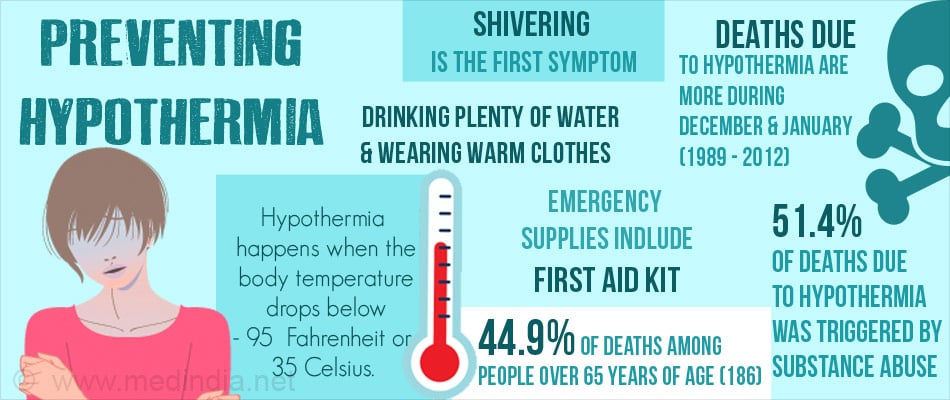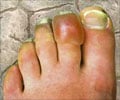- Hypothermia - (http://www.mayoclinic.org/diseases-conditions/hypothermia/basics/definition/con-20020453)
- Mark Luscombe, John C Andrzejowski, "Clinical applications of induced hypothermia"; Online ISSN 1743-1824 - Print ISSN 1743-1816
- About Hypothermia - (https://www.nlm.nih.gov/medlineplus/hypothermia.html)
What is Hypothermia?
Hypothermia is a condition in which the body temperature starts dropping due to the loss of heat and is unable to produce heat as fast as it loses it. This condition could occur gradually without the individual noticing in cold weather conditions or it could be very rapid like if an individual falls into a lake at near freezing temperature.
Normal body temperature: 980 Fahrenheit or 370 Celsius
Hypothermia: 950Farenheit or 350 Celsius and below
Hypothermia can be mild to severe depending on the temperature and length of exposure to the cold.
A. Mild hypothermia: When the temperature of the individual is between 890- 950 F or 320-350 C, then it is considered to be mild hypothermia.
B. Moderate hypothermia: When the temperature of the individual is between 820-890 F or 280-320 C, then it is considered to be moderate hypothermia.
C. Severe hypothermia: Temperature below 820 F or 280 C is considered to be severe hypothermia.

How Does the Body Regulate Temperature?
The human body has the ability to control temperature changes with the body temperature maintained between 980F and 1000F within an ambient temperature range of 680 F and 1300 F.
The hypothalamus of the brain plays an important role in maintaining body temperature via negative feedback mechanism as it contains the control mechanisms as well as temperature sensors that are necessary for temperature regulation.
Sweating or perspiration is a method of maintaining temperature or decreasing the body temperature and the body starts sweating when body temperature reaches 980F. When the temperature increases, the extent of perspiration also increases while the production of heat remains constant.
When the temperature of the body drops below 980F, the body begins to conserve the heat through various mechanisms.
- Sweating stops or doesn’t occur at lower temperature.
- The production of heat in the muscles is accelerated through shivering.
- The skin is the surface through which heat is lost and the body tries to conserve body heat using vasoconstriction of vessels that pass beneath the skin surface and this low flow means less heat being lost through the exposed skin surface. Extreme exposure leads to frostbite and sometimes gangrene as this protective mechanism stops the flow of blood to such areas.
- To increase the production of heat, hormones epinephrine, norepinephrine and thyroxine are secreted.
What are the Methods of Heat Transfer?
There are four different methods of heat transfer from the skin.
- Perspiration or Evaporation: Perspiration aids in cooling the body temperature as the water droplets lower heat. Normally, a person sweats about 0.5 liters up to a maximum of 1.5 liters/hour (after strenuous exercise) while the volume could increase to 3.5 to 6 liters in a day if the person is an athlete and does work outs in a tropical climate.
- Convection: Heat is transferred to the surrounding environment, i.e, the air around the body through the process of convection.
- Conduction: In the body, convection and conduction methods of maintaining body temperature transfer heat to the surrounding air, but are not solely adequate for maintaining optimum temperature.
- Radiation: Heat is transferred by radiation where heat energy moves from the source of heat to cooler regions.

What is the Significance of Maintaining an Optimum Body Temperature?
The body needs to be maintained at an optimum temperature to ensure that the metabolic processes are functioning well. When the temperature rises too high, then proteins in enzymes begin to denature and cannot function, while at cooler temperatures the enzymes slow down important metabolic processes.
In hypothermia, there is a reduction in body temperature that affects many metabolic processes.
What are the Causes and Risk Factors of Hypothermia?
Hypothermia is caused when the individual:
- Meets with accidents in the cold.
- Falls into freezing cold water.
- Wears clothes that are wet when the temperature is low.
- A mentally ill person is unable to discern cold weather condition and take protective action.
- Homeless people are prone to exposure and the vagaries of nature.
- When an individual has certain medical conditions like lung infections, heart ailments, diabetes or infections that make him more prone to hypothermia.
- Use of narcotics, tranquilizers or alcohol makes people more prone to hypothermia.
- Elderly over 65 years of age and babies are more prone to exposure to cold and are more susceptible to hypothermia.
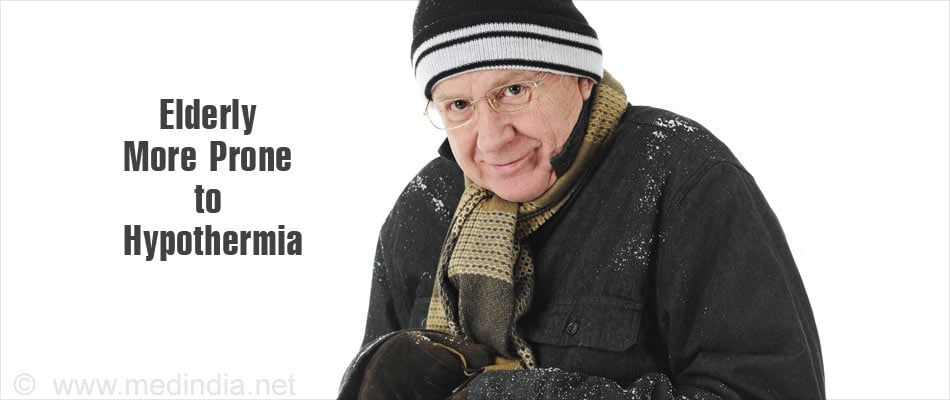
What are the Symptoms of Hypothermia?
The symptoms of hypothermia are:
- Shivering: This is one of the first symptoms that is noticed in a person who is exposed to cold temperatures. Shivering is noticed till the body is able to regulate temperature. When the temperature drops lower, shivering stops.
- Mental Symptoms: The person shows memory loss and confusion. The patient also gets drowsy and exhausted. In severe cases, the person may lose consciousness.
- Speech: The speech becomes slurred and difficult to understand, with no coherence.
- Pulse: Slow and weak.
- Breathing: The breathing becomes shallow and slow as the temperature drops.
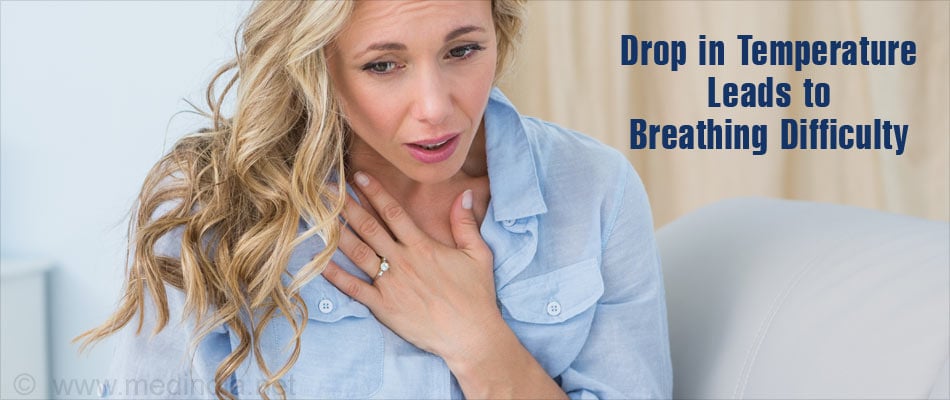
Infants placed in cold rooms sometimes suffer from hypothermia, and their symptoms include cold skin with redness and lowered energy levels.
On examination, they have cold clammy pale skin, bluish lips, dry mouth, weak and slow pulse and when the temperature is measured, it shows lower than normal. In severe exposure, there may be features of frostbite and gangrene of the toes or digits of the hand.
Symptoms Based on Temperature
| Core temperature/ Symptoms | Mild Hypothermia (35-320C) | Moderate symptoms (320C to 280C) | Severe symptoms (<270C) |
| General symptoms | Shivering: Starts at around 360C, which becomes severe at 340C and then decreases at 330C. Foot stamping is noticed. | Shivering becomes almost non-existent, there is muscle rigidity. | The patient appears dead. |
| Heart and lung related symptoms | Blood vessels become constricted, BP is lowered. | The pulse drops and so does the respiratory rate. Cardiac arythmias occur. | Cardiac arrest |
| Nervous system symptoms | Speech is slurred, there is an increase in confusion. | Pupils are dilated and there is no movement of the hands or the legs. | Brain death below 240C |
| Consciousness | Quiet and withdrawn | Signs of lethargy and confusion. May become unresponsive below 310C. | Unresponsive |
How to Diagnose Hypothermia?
Babies with hypothermia may look healthy, but their skin will turn cold and they will be lethargic.
Adults who are suffering from hypothermia will be checked for symptoms and signs are looked as described earlier. While there are no lab tests in particular for this condition, a special thermometer available in hospitals is used to check the temperature of the individual.
Temperature of the Individual and the Extent of Hypothermia:
When hypothermia is detected, there are other diagnostic procedures that are performed to identify damage to organs in the body.
- CT scan of the brain to detect damage to the brain.
- Chest X-Ray to identify the presence of fluid in the lungs or to detect pneumonia.
- Coagulation studies: To detect for intravascular coagulation.
- ECG: To study the condition of the heart and its rhythm.
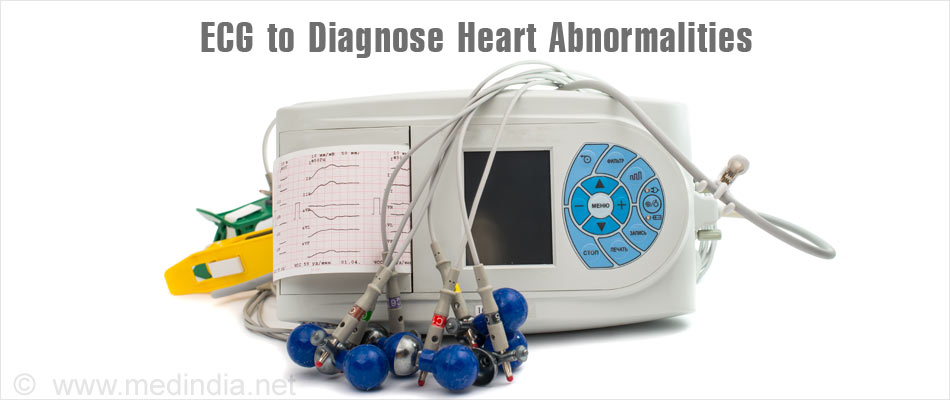
What is the First Aid That Should be Given to a Person Suffering from Hypothermia?
Hypothermia is a potentially life threatening condition and immediate care is very important. The individual suffering from hypothermia should be taken to a hospital, but till the transfer to a hospital, it is important to provide immediate care.
The first aid to be provided depends on whether the individual is conscious or not. If the individual is conscious, then the following first aid measures should be carried out.
Move to a Warm Place:
The individual suffering from hypothermia should be taken indoors or to a warm place. If the clothes are wet, then they should be removed immediately and the individual should be wiped dry. The person should be shielded from direct cold drafts of wind that can continue to induce hypothermia in the individual.
Provide Warmth:
Heating pads should be used for the neck, arm pits and groin so that the body regains some warmth. However, there have been instances of burn injuries due to excessive heating and so caution should be exerted.
If there are no warming pads, then the body temperature of the aid worker is the next best option. Placing the affected individual close or hugging them will help in passing on some warmth.
Provide a Warm Drink:
The affected individual should be given a warm drink. No caffeine or alcohol containing drinks should be offered as they lead to heat loss.
If the individual is unconscious, then no drink should be forced orally.
The pulse of the individual should be checked carefully, sometimes the pulse could be very faint or feeble.
If there is a pulse, then there is no need to start a Cardiopulmonary resuscitation. When there is no detectable pulse, then a Cardiopulmonary resuscitation should be started. Once the Cardiopulmonary resuscitation is started, it should be continued till help arrives.
How Do You Treat Hypothermia?
The patient should be transferred to a hospital as soon as possible so that precautionary tests and essential diagnosis can be carried out.
Critical Care Unit: When the patient reaches the hospital, he is transferred to the intensive care unit.
Treatment of Wounds/Conditions: Any injury to the body, frost bites, sepsis or conditions like diabetes are treated.
Oxygen Support: The patient is administered with warmed oxygen to aid in breathing.
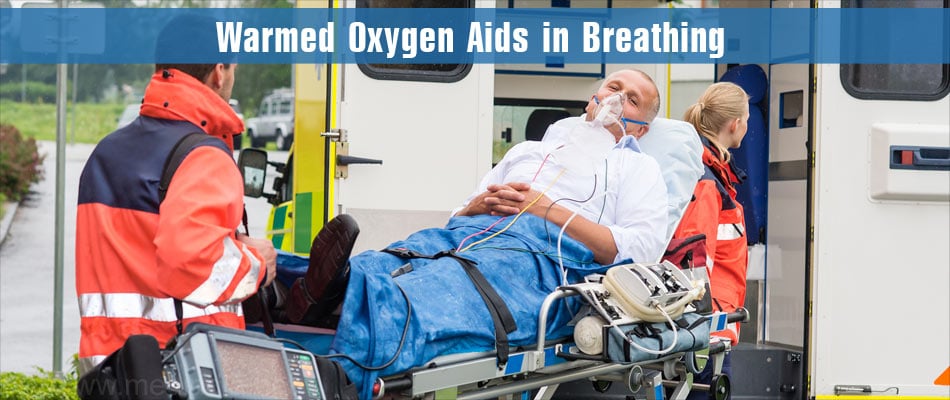
Re-warming: The patient is carefully re-warmed and brought to the normal temperature to facilitate recovery. This is done using a hypothermia wrap that essentially warms the whole body while providing additional warmth to the neck, armpits and groin.
In severe hypothermia, surgical re-warming procedures like peritoneal lavage or A-V rewarming procedures are performed.
Diagnosis: Diagnostic procedures are carried out to study the effect of hypothermia on the various organs in the body.
Determination of Death: Death cannot be announced till the body is warmed to at least 350C, though the patient may seem like in a state of death.
Drugs: There are no specific drugs that are given for hypothermia. To warm the blood, a warm IV salt water solution may be given while the use of humidified oxygen is used to warm the airways.
How Do You Prevent Hypothermia?
- Hypothermia can be prevented if it is a gradual process like weather change that lowers the temperature. In such instances, additional clothing should be worn to keep the body warm. Wet clothing should be removed immediately as wet clothing increases the chance of hypothermia 5 to 10 folds.
- Elderly or the very young should not be exposed to cold weather conditions without adequate protection.
- People walking on frozen lakes should be careful about thin ice and the chances of falling into the extremely cold lake below.
- If you are suffering from disease such as lung infection or have a heart problem or diabetes, you should be doubly careful in cold weather.
- Over exertion that leads to excessive sweating should be avoided.
- Avoid excessive alcohol consumption in cold weather.

What is Therapeutic Hypothermia?
Therapeutic hypothermia is a carefully monitored lowering of the body temperature of an individual to prevent cerebral injury. Patients who are suffering from cardiac arrest, neonatal encephalopathy or a brain injury are candidates for this procedure.
The hindrances to this procedure are immunosuppression, diuresis and electrolyte imbalance.
Health Tips
- Be extra careful with small children and the elderly when stepping out in the cold weather.
- Drink plenty of water.
- Travel with a partner or in groups when trekking or hiking.
- Eat well before going out in winter to ensure that the body has enough energy to withstand some amount of cold.
- When there is lack of heating and when out in the cold, huddle together with partner or friends to ensure warmth. Keep children and elderly at the center.
